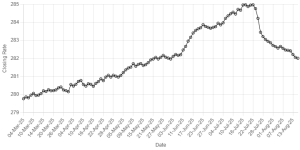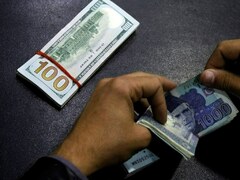 MUMBAI: For bond investors, the question is not whether India will have to raise its gross borrowing target of 5.97 trillion Indian rupees ($97.8 billion) for the year starting in April, but by how much.
MUMBAI: For bond investors, the question is not whether India will have to raise its gross borrowing target of 5.97 trillion Indian rupees ($97.8 billion) for the year starting in April, but by how much.
A key indicator of how much more debt India will need to sell is expected on Friday when the government will announce its borrowing calendar for the first half of the fiscal year after a meeting between finance ministry and central bank officials.
Bond investors in India focus on debt borrowing levels given their importance in containing the country's fiscal deficit and helping to finance government spending. India has traditionally raised 60-65 percent of its yearly borrowing in April to September, but analysts warn a similar amount this time may spark a sell-off that could quickly send longer-dated yields up by 8-12 basis points (bps).
By contrast, a lower amount of borrowing in the first half would be a relief, and prompt market watchers to reduce estimates for the full amount of debt the government would end up raising this year. For now, bond markets are bracing for the tougher scenario.
A rally that has sent shares to record highs and the rupee to a near eight-month high in March has largely skipped debt markets, with benchmark 10-year bond yields down a relatively mild 4 bps.
"The market has remained volatile, but is not settling anywhere," said Arvind Chari, head of fixed income and alternatives at Quantum Advisors. "As supply begins, yields should trend higher." Although the ruling Congress kept its fiscal deficit at 4.6 percent of gross domestic product (GDP) in the year ending in March, below its target of 4.8 percent, analysts say that was achieved by sharply reducing spending in recent months.
Whether the opposition Bharatiya Janata Party wins elections set to conclude by May, as is widely expected, or whether the ruling Congress party pulls off an upset, analysts believe the new government would find it hard to maintain that type of fiscal discipline.
The Indian economy depends on government spending, which accounted for 14 percent of GDP this fiscal year, a key factor at a time when growth is at a decade low.
As a result, scepticism abounds about any government meeting the country's current target of a fiscal deficit of 4.1 percent for 2014/15. That level, if achieved, would be the lowest in seven years.
"A large part of expenditure has been pushed to next year to show there is fiscal consolidation," said Rupa Rege Nitsure, chief economist at Bank of Baroda. "The next government will have to manage this fiscal profligacy of the current government, and there is no doubt borrowing will also have to be raised," she added.
A typical, front-loaded government borrowing pattern in the first half of the year would reinforce those fears, especially if India announces weekly auctions above the average 120-150 billion rupees seen in the first half of the year.
Traders will also focus on the tenor of debt being issued by the government given its impact on India's yield curve, which remains inverted as tight cash conditions have kept short-term yields high.
A typically heavy load of 10-15 year debt issuances - given that's the most liquid part of the yield curve - would likely push longer-dated yields higher.
That in turn would likely lead investors to shorter-dated debt, especially as cash conditions are expected to improve on the back of 407 billion rupees in redemptions in April, bringing these yields down.






















Comments
Comments are closed.